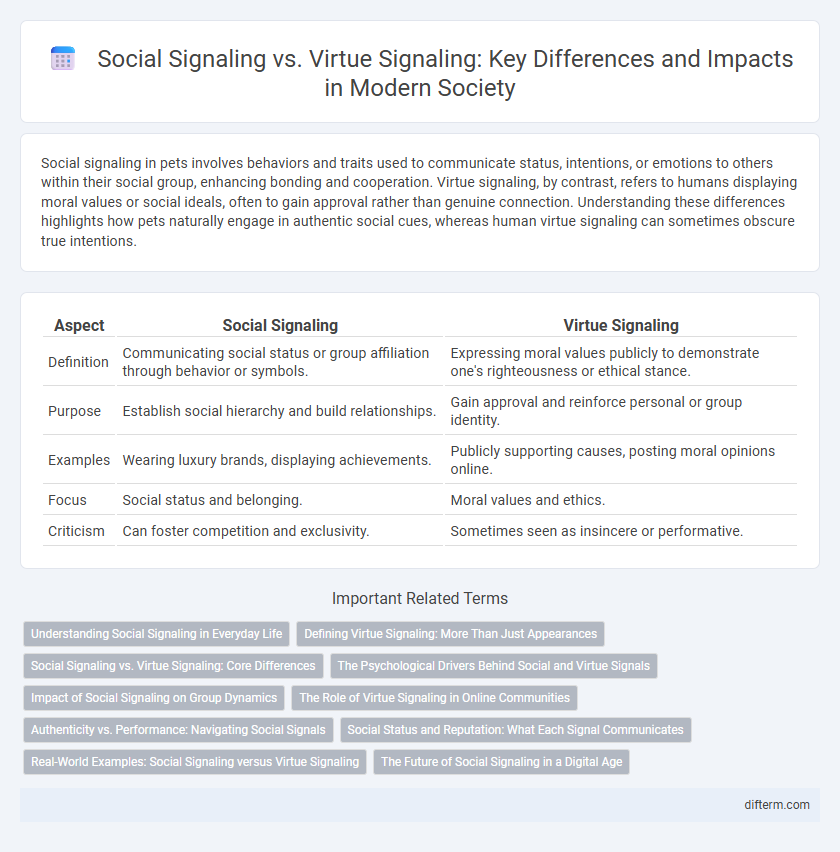Social signaling in pets involves behaviors and traits used to communicate status, intentions, or emotions to others within their social group, enhancing bonding and cooperation. Virtue signaling, by contrast, refers to humans displaying moral values or social ideals, often to gain approval rather than genuine connection. Understanding these differences highlights how pets naturally engage in authentic social cues, whereas human virtue signaling can sometimes obscure true intentions.
Table of Comparison
| Aspect | Social Signaling | Virtue Signaling |
|---|---|---|
| Definition | Communicating social status or group affiliation through behavior or symbols. | Expressing moral values publicly to demonstrate one's righteousness or ethical stance. |
| Purpose | Establish social hierarchy and build relationships. | Gain approval and reinforce personal or group identity. |
| Examples | Wearing luxury brands, displaying achievements. | Publicly supporting causes, posting moral opinions online. |
| Focus | Social status and belonging. | Moral values and ethics. |
| Criticism | Can foster competition and exclusivity. | Sometimes seen as insincere or performative. |
Understanding Social Signaling in Everyday Life
Social signaling involves conveying information about one's status, intentions, or group membership through behaviors, dress, or language to influence others' perceptions in everyday interactions. Unlike virtue signaling, which often aims to showcase moral superiority or ethical alignment, social signaling encompasses a broader range of motivations including trust-building and alliance formation. Recognizing subtle cues such as body language or communication style helps decode social signaling and improve interpersonal dynamics in both personal and professional settings.
Defining Virtue Signaling: More Than Just Appearances
Virtue signaling involves publicly expressing opinions or actions primarily to showcase moral correctness rather than to effect genuine change. Unlike general social signaling, which conveys social status or group identity, virtue signaling specifically highlights ethical values to gain approval or enhance reputation. Understanding this distinction is crucial for analyzing social behaviors and motivations in digital and offline interactions.
Social Signaling vs. Virtue Signaling: Core Differences
Social signaling involves conveying information about oneself through actions or symbols to gain social benefits or establish identity, often rooted in genuine social interactions. Virtue signaling specifically refers to expressing moral values publicly to enhance one's social standing or reputation without substantial commitment to the cause. The core difference lies in social signaling's broader scope, encompassing varied social motives, while virtue signaling centers on moral or ethical self-presentation.
The Psychological Drivers Behind Social and Virtue Signals
Social signaling and virtue signaling both serve as mechanisms for individuals to influence group perception, driven by psychological needs for belonging and self-esteem. Social signaling often involves displaying traits or achievements directly linked to one's social status or group affiliation, while virtue signaling focuses on expressing moral values to gain social approval without necessarily engaging in corresponding actions. These behaviors are motivated by a desire to manage impressions in social contexts and reinforce identity within specific communities.
Impact of Social Signaling on Group Dynamics
Social signaling plays a crucial role in shaping group dynamics by influencing perceptions of status, trust, and cooperation among members. Unlike virtue signaling, which often serves to display moral superiority, social signaling fosters real-time feedback and alignment of behaviors that enhance group cohesion and collective identity. Effective social signals can strengthen group norms, encourage pro-social actions, and reduce conflicts, ultimately improving overall group performance.
The Role of Virtue Signaling in Online Communities
Virtue signaling in online communities often serves as a social signaling mechanism to showcase moral values and align with group norms. This behavior enhances social cohesion by reinforcing shared beliefs but can also lead to performative actions lacking genuine commitment. Understanding the dynamics of virtue signaling helps in analyzing social interactions and authenticity within digital platforms.
Authenticity vs. Performance: Navigating Social Signals
Social signaling reflects genuine expressions of beliefs and values that shape authentic relationships, while virtue signaling often involves performative actions aimed at gaining social approval without true commitment. Authentic social signals build trust and credibility by consistently aligning words with actions, whereas performance-based signals risk eroding trust due to perceived insincerity. Understanding the distinction between authenticity and performance in social signaling is crucial for fostering meaningful connections and promoting genuine social change.
Social Status and Reputation: What Each Signal Communicates
Social signaling conveys authentic behaviors aligned with group norms to enhance social status through genuine reputation building. Virtue signaling often involves public displays of moral values aimed at gaining approval or prestige without substantial action, risking reputational damage if perceived as insincere. Understanding these distinctions reveals how social status is maintained or manipulated through different communicative strategies.
Real-World Examples: Social Signaling versus Virtue Signaling
Social signaling often manifests in everyday acts such as wearing team apparel or using eco-friendly products, signaling group identity or values without necessarily invoking moral judgment. Virtue signaling, conversely, tends to appear in public statements or social media posts aimed at showcasing one's moral correctness, like corporate pledges on climate change released during global summits. Real-world examples include individuals donating to charity quietly as social signaling, while politicians publicly denouncing opponents on issues like human rights often reflect virtue signaling.
The Future of Social Signaling in a Digital Age
The future of social signaling in a digital age increasingly intertwines with data-driven algorithms that amplify visible acts of social identity and group affiliation, moving beyond traditional virtue signaling. Emerging platforms prioritize authenticity through real-time interactions, leveraging biometric feedback and AI to measure genuine social engagement and influence. This evolution redefines social capital, shifting from performative displays to verifiable social value and trustworthiness in online ecosystems.
social signaling vs virtue signaling Infographic

 difterm.com
difterm.com